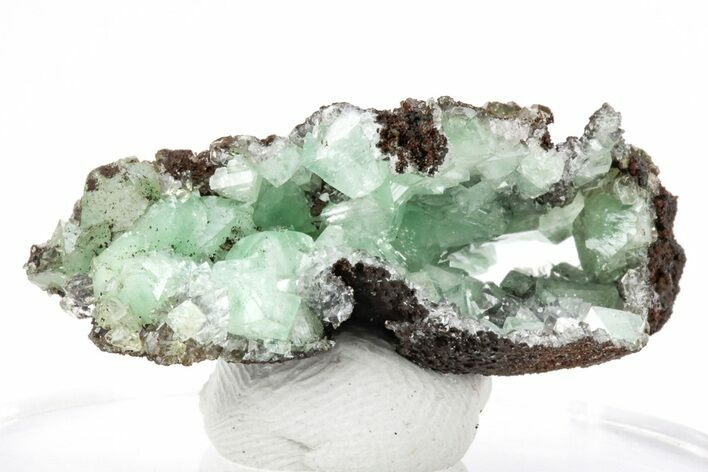This Specimen has been sold.
1.3" Cuprian Adamite Crystals on Matrix - Ojuela Mine, Mexico
This is a beautiful specimen of sparkling, green, cuprian (copper-bearing) adamite crystals on a limonite matrix, collected from the Ojuela Mine in Durango, Mexico. The entire specimen measures 1.3" wide and has been mounted to an acrylic display base with mineral tack.
About Adamite
Adamite is a basic zinc arsenate with the base chemical formula of Zn2(AsO4)(OH). When impurities are present in the mineral, the color is altered, explaining the wide variety of colors that adamite displays. Copper and cobalt are some well-known impurities that can give mineral specimens a green (Cu) to pink/red (Co) color. Adamite is typically found imbedded in a limonite matrix, formed as a secondary mineral in oxidation zones of hydrothermal replacement deposits.
Adamite is a basic zinc arsenate with the base chemical formula of Zn2(AsO4)(OH). When impurities are present in the mineral, the color is altered, explaining the wide variety of colors that adamite displays. Copper and cobalt are some well-known impurities that can give mineral specimens a green (Cu) to pink/red (Co) color. Adamite is typically found imbedded in a limonite matrix, formed as a secondary mineral in oxidation zones of hydrothermal replacement deposits.
About The Ojuela Mine
Ojuela is not one mine but a complex of multiple mines in the same general area, located just northwest of Mapimi, Mexico. It was established in 1598 after the discovery of an old abandoned silver and gold mine. As mineral production increased and the mineral potential was confirmed, the town (Ojuela settlement) adjacent to the mine, along with the city of Mapimi, began to grow as well. The mining settlement was such a success that it contained a post office, warehouses, stores, saloons, a church, and housing for the miners. Once minerals were collected, they were processed in Mapimi, which also played a role in the rapid development of the city. Around the start of the 20th century, most of the mineral deposits were exhausted, resulting in the abandonment of the mines and settlement.
The mine is well known by mineral collectors for its aresenate minerals and a variety of other mineral species: approximately 117 have been identified from the area. Some of the most popular minerals include adamite, austinite, hemimorphite, scorodite, platternite, aurichalcite, rosasite, calcite, wulfenite, mimetite, iridescent goethite, and fluorite.
Ojuela is not one mine but a complex of multiple mines in the same general area, located just northwest of Mapimi, Mexico. It was established in 1598 after the discovery of an old abandoned silver and gold mine. As mineral production increased and the mineral potential was confirmed, the town (Ojuela settlement) adjacent to the mine, along with the city of Mapimi, began to grow as well. The mining settlement was such a success that it contained a post office, warehouses, stores, saloons, a church, and housing for the miners. Once minerals were collected, they were processed in Mapimi, which also played a role in the rapid development of the city. Around the start of the 20th century, most of the mineral deposits were exhausted, resulting in the abandonment of the mines and settlement.
The mine is well known by mineral collectors for its aresenate minerals and a variety of other mineral species: approximately 117 have been identified from the area. Some of the most popular minerals include adamite, austinite, hemimorphite, scorodite, platternite, aurichalcite, rosasite, calcite, wulfenite, mimetite, iridescent goethite, and fluorite.
SPECIES
Adamite var. Cuprian Adamite
LOCATION
Ojuela Mine, Mapimi, Durango, Mexico
SIZE
Entire specimen 1.3 x .95"
CATEGORY
ITEM
#211976
 Reviews
Reviews













